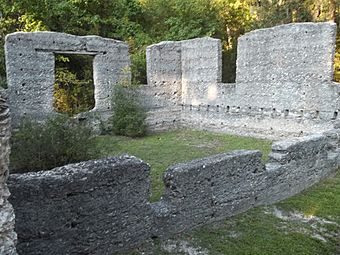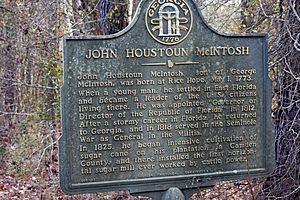McIntosh Sugarworks facts for kids
Quick facts for kids |
|
|
McIntosh, John Houstoun, Sugarhouse
|
|

Ruins on the site
|
|
| Location | Ga. Spur 40, 6 mi. N of St. Marys, St. Marys, Georgia |
|---|---|
| Area | 1 acre (0.40 ha) |
| NRHP reference No. | 92000167 |
| Added to NRHP | April 2, 1992 |
The McIntosh Sugarworks are the ruins of an old sugar mill. They were built in the late 1820s by a man named John Houstoun McIntosh. These ruins are a great example of tabby architecture. Tabby is a special kind of concrete made from oyster shells, sand, and water.
The sugarworks show how sugar was made on large farms, called plantations, in the southeastern United States a long time ago. People also know these ruins as the Tabby Ruins. You can find them near St. Marys, Georgia, in Camden County, Georgia. This historic site was added to the National Register of Historic Places on April 2, 1992. This means it is an important place in history.
Contents
Discovering the McIntosh Sugarworks

John Houstoun McIntosh started farming in Camden County, Georgia, after the War of 1812. He made his home at Mariana Plantation, which was located on the St. Marys River. In 1819, he bought two more plantations. He then combined all his land and called it New Canaan.
A person named Thomas Spalding suggested a sugar mill design to McIntosh in 1825. By 1829, the McIntosh mill was already making sugar.
What Happened After McIntosh?
John Houstoun McIntosh passed away in 1836. His New Canaan plantation was sold to Caroline Hallowes in 1840. The Hallowes family changed the plantation's name to Bollingbrook. They lived there until after the Civil War.
During the war, Colonel Hallowes grew sugar cane and made sugar. He also used the tabby sugarworks as a starch factory. They made a lot of arrowroot starch there. For many years, people thought these "tabby ruins" were an old Spanish mission. Other tabby sugarhouses can be found in the area, like the one at Elizafield Plantation on St. Simons Island.
How Sugar Was Made at McIntosh Sugarworks
People in North America probably started trying to grow sugar in the early 1700s. By the late 1700s, sugar became a very successful crop in the southern United States. Sugarcane was a valuable crop, especially for big plantations.
In Georgia at that time, large farms mostly grew rice. Sugar cane needed a different way of growing. However, it did not need a completely different type of farm. For John Houstoun McIntosh, growing sugar added another valuable crop to his plantations. It did not cost him much extra money.
The Sugar Making Process
Processing the sugar was a big job, as the large sugarhouse shows. Building the sugarhouse itself needed a lot of materials and many workers. Thomas Spalding thought that one worker could harvest cane from two acres in two months. Many workers cut the cane, removed the leaves, and loaded it onto carts. These carts then took the cane to the mills.
The standing tabby walls of the sugarhouse form a rectangular building. It has three rooms in a row, with two porches off the middle room. The McIntosh sugar mill's three rooms were used for different steps of the process. This made sugar production very efficient. The middle room had a dirt floor. The two end rooms had wooden floors, supported by the tabby walls.
Crushing the Cane
The room on the eastern side held the mill. This mill crushed the cane to get out the sweet juice. Thomas Spalding said it was "the first horizontal cane mill worked by cattle power." Horizontal mills were a new idea for making sugar in the 1820s. McIntosh bought his mill from the West Point Foundry in New York. This mill room was the only two-story room in the sugarhouse. The mill itself was on the second story, and the animals that powered it were below.
Boiling the Juice
In the middle room, the juice was boiled and cleaned to make a syrup. Then, the syrup was left to turn into sugar crystals. The molasses was drained away. The middle room had a dirt floor instead of wood. This was because of the high heat and open flames used to boil the syrup. The boiling process used several large kettles. These kettles allowed for different stages of turning the juice into syrup.
Finishing the Sugar
In the last room, the syrup was poured into containers. Here, it turned into granular sugar crystals. The molasses was then poured out of the finished sugar. Both the sugar crystals and the molasses could be sold. The leftover cane, called bagasse, could be dried. It was then used to fuel the boiling room or as animal feed.
Images for kids





